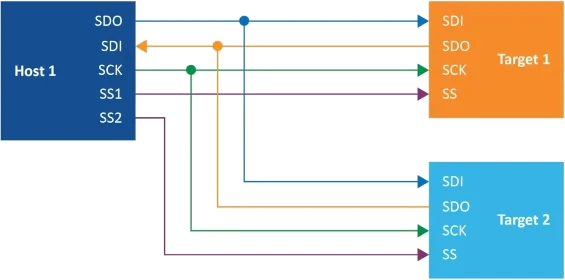Choosing a TFT Display with SPI Interface for Your Embedded System
Selecting the right display for an embedded system is a critical design choice that impacts everything from hardware complexity to user experience. While high-speed interfaces like RGB or MIPI are powerful, they often come with a high pin count and increased complexity. For a huge range of applications, a TFT display with an SPI interface for embedded systems offers the perfect balance of performance, simplicity, and cost-effectiveness.
But how do you know if an SPI TFT is the right choice for your project? This guide will walk you through the benefits, key technical considerations, and how to select the perfect display for your needs.
What is an SPI Interface?
SPI, or Serial Peripheral Interface, is a simple and versatile synchronous serial communication protocol. It uses a master-slave architecture with just a few wires, making it a favorite among embedded engineers.
A standard SPI connection requires only four signal lines:
- SCLK (Serial Clock): The clock signal that synchronizes data transfer, driven by the master.
- MOSI (Master Out, Slave In): The data line from the master to the slave.
- MISO (Master In, Slave Out): The data line from the slave back to the master.
- CS (Chip Select): Allows the master to select which slave device it wants to communicate with.

This straightforward setup is one of the primary reasons it's a go-to interface for connecting peripherals like sensors, memory chips, and of course, LCD displays.
Why Choose a TFT Display with an SPI Interface?
When you're designing a compact or cost-sensitive embedded system, every component and every pin on your microcontroller (MCU) counts. This is where SPI shines. There are 4 key benefits, for using SPI interface in your embedded system.
1. Extremely Low Pin Count
Compared to parallel interfaces that can require 8, 16, or even 24 data lines plus control signals, SPI needs just 3 or 4 pins. This frees up valuable GPIOs on your MCU for other tasks, simplifies your PCB layout, and reduces potential points of failure.
2. Simple Protocol and Wide MCU Support
The SPI protocol is far less complex than high-speed differential interfaces. The software overhead is minimal, and virtually every microcontroller on the market—from tiny 8-bit MCUs to powerful 32-bit processors—has at least one built-in SPI hardware peripheral. This makes driver development faster and firmware easier to manage.
3. Cost-Effectiveness
Fewer pins and simpler routing directly translate to lower costs. A 2-layer PCB is often sufficient for an SPI-based design, whereas more complex interfaces may require a more expensive 4-layer board to manage signal integrity.
4. Sufficient Speed for Most HMI Applications
While not as fast as parallel or MIPI interfaces, modern SPI clock speeds (often running at 20-80 MHz) are more than capable of handling the graphical demands of most embedded products. For devices that require displaying sensor data, status menus, or simple user interfaces, SPI provides smooth updates without the hardware overhead.
Key Considerations When Selecting an SPI TFT Display
Before you finalize your choice, consider these technical trade-offs:
- Resolution vs. Refresh Rate: SPI is ideal for small to medium-sized displays (typically from 1.0" to 5.0"). For very high-resolution displays requiring full-motion video, the bandwidth of SPI might become a bottleneck, leading to slower refresh rates. Always calculate the data throughput your application requires.
- Display Controller IC: The integrated controller on the display (e.g., ILI9341, ST7789, GC9A01) is just as important as the interface. It manages the low-level driving of the LCD panel. Ensure the controller is well-documented and has good community or vendor support, as this will save you countless hours in development.
- Memory (GRAM): The display controller includes Graphics RAM (GRAM) where the pixel data is stored. The MCU writes data to this GRAM via the SPI bus. The size and architecture of this memory affect how quickly you can update the screen.
- Shared Bus: If the SPI bus is shared with other peripherals (like a sensor and an SD card), be mindful of potential bus contention and ensure your MCU can manage the data traffic efficiently.
Find Your Perfect SPI TFT Display with Topway
A TFT display with an SPI interface for embedded systems is a robust, cost-effective, and reliable choice for countless industrial, medical, and commercial products. But the success of your project depends on a supplier who understands the technical nuances and can provide a high-quality, dependable module.
At Topway, we have over three decades of experience in manufacturing a wide range of TFT displays with SPI and other interfaces. Our engineering team can help you navigate the technical trade-offs and select the perfect display that meets your performance, power, and cost targets.
Ready to simplify your next embedded design? Explore our range of TFT Display Modules or contact our team today for a personalized consultation.
